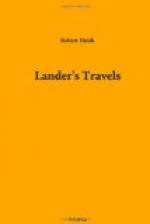The town of Sockatoo lies in latitude 13 deg. 4’ 52” north, and longitude 6 deg. 12’ east, and is situated near the junction of an inconsiderable stream, with the same river which flows past Zirmee, and which taking its rise between Kashna and Kano, is said to fall into the Quarra four days’ journey to the west. The name in their language signifies, a halting place, the city being built by the Fellatas, after the conquest of Goober and Zamfra, as near as Clapperton could learn about the year 1805. It occupies a long ridge, which slopes gently towards the north, and appeared to Clapperton the most populous town he had visited in the interior of Africa, for unlike most other towns in Houssa, where the houses are thinly scattered, it is laid out in regular well-built streets. The houses approach close to the walls, which were built by the present sultan in 1818, after the death of his father; the old walls being too confined for the increasing population. This wall is between twenty and thirty feet high, and has twelve gates, which are regularly closed at sunset. There are two large mosques, including the new one which was then building by the gadado, besides several other places for prayer. There is a spacious market-place in the centre of the city, and another large square in front of the sultan’s residence. The inhabitants are principally Fellatas, possessing numerous slaves. Such of the latter as are not employed in domestic duties, reside in houses by themselves, where they follow various trades; the master of course reaping the profit. Their usual employments are weaving, house-building, shoemaking, and iron work, many bring firewood to the market for sale. Those employed in raising grain and tending cattle, of which the Fellatas have immense herds, reside in villages without the city. It is customary for private individuals to emancipate a number of slaves every year, according to their means, during the great feast after the Rhamadan. The enfranchised seldom return to their native country, but continue to reside near their old masters, still acknowledging them as their superiors, but presenting them yearly with a portion of their earnings. The trade at Sockatoo is at present inconsiderable, owing to the disturbed state of the surrounding country. The necessaries of life are very cheap, butchers’ meat is in great plenty and very good. The exports are principally civet, and blue check tobes called sharie, which are manufactured by the slaves from Nyffee, of whom the men are considered the most expert weavers in Soudan, and the women the best spinners. The common imports are goora nuts, brought from the borders of Ashantee, and coarse calico and woollen cloth in small quantities, with brass and pewter dishes, and some few spices from Nyffee.
The Arabs from Tripoli and Ghadamis bring unwrought silk, attar of roses, spices and beads; slaves are both exported and imported. A great quantity of guinea coin is taken every year by the Tuaricks, in exchange for salt. The market is extremely well supplied, and is held daily from sunrise to sunset.




